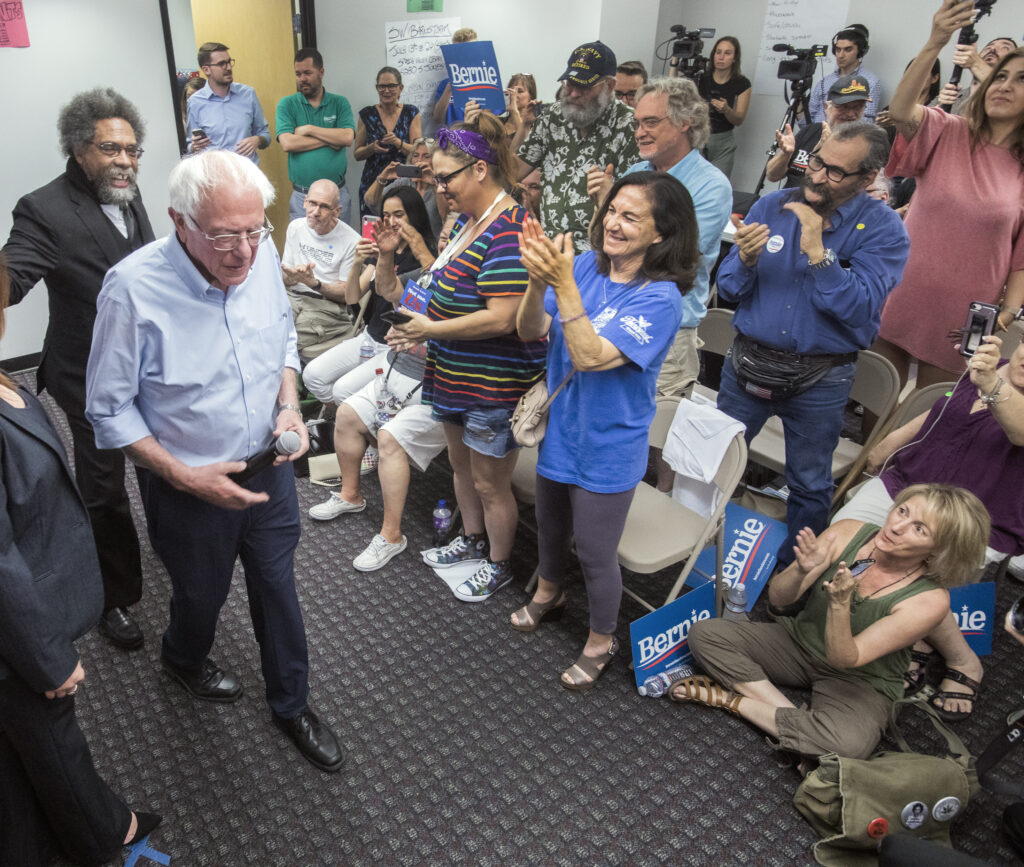Wounds from 2016 Democratic caucuses remain raw for some Sanders supporters despite state party salve
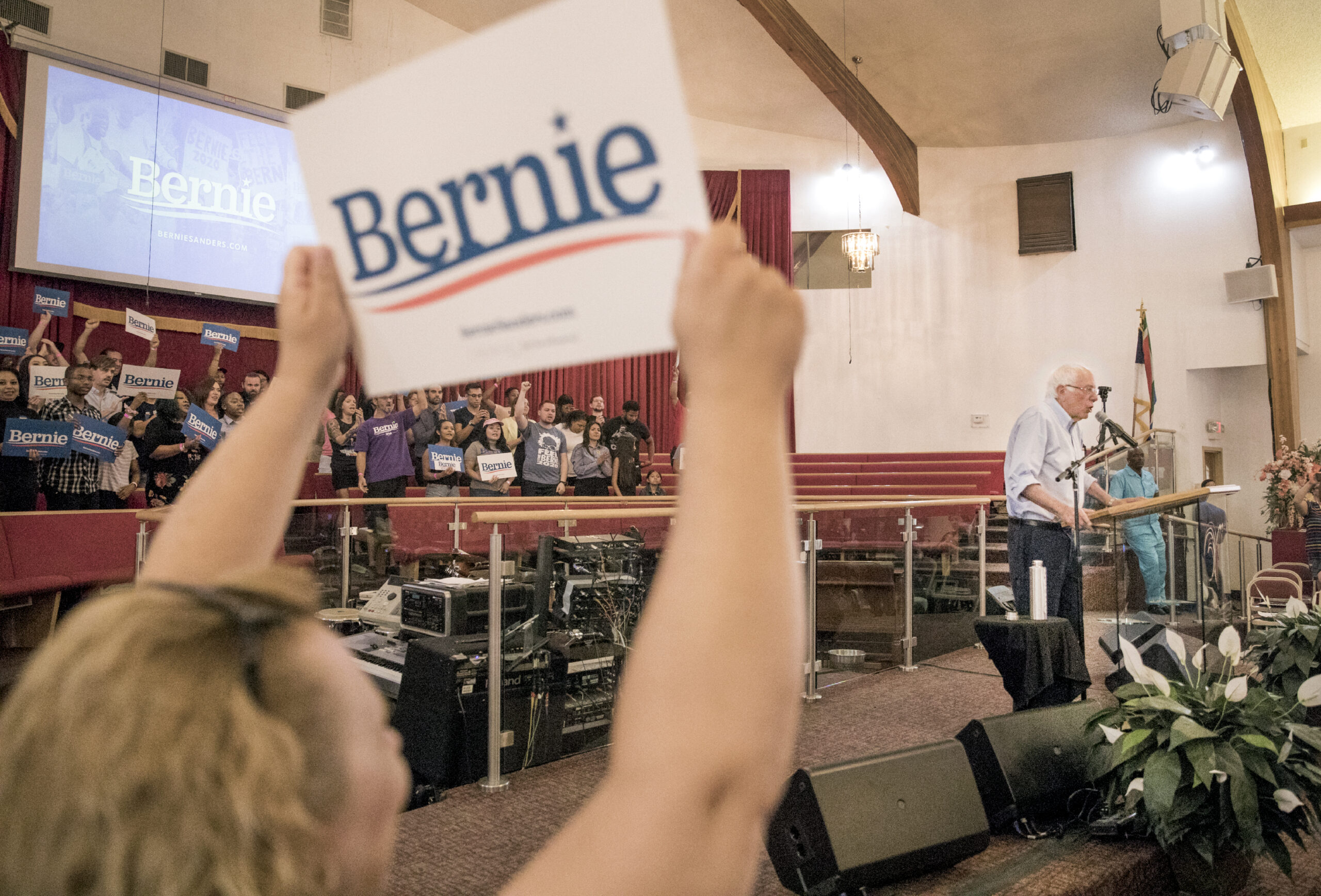
Maria Walters is a Bernie Sanders fan.
A picture of the Vermont senator from a recent rally is the background on her phone. She’s active in Facebook groups supporting the Democratic presidential hopeful. As a stay-at-home mom, she finds it hard to make time to volunteer, but she and her husband have donated bits of cash here and there to his campaign. Her friends, she joked, have accepted that she is a “psycho Bernie supporter.”
“Whatever Bernie says, I am for it,” Walters said in an interview before Sanders spoke at Victory Missionary Baptist Church last month.
Walters, 44, supported the self-described democratic socialist during his first run for president in 2016, and she is all in for him in 2020. But, like many supporters of Sanders’ from last time, she has serious reservations about the Democratic Party going into the next election cycle.
For many Sanders supporters, the confusing Nevada caucuses three and a half years ago gave way to an even more confounding and frustrating convention process where they felt the deck was stacked against them and for former Secretary of State Hillary Clinton. Tensions flared at the Nevada State Democratic Convention, where Sanders supporters argued that their delegates had been inappropriately disqualified, Clinton took the delegate lead, Sanders supporters wouldn’t concede, a Schrodinger’s cat of chairs were either thrown or not thrown, and casino security eventually turned off the lights to shut the convention down when the event ran over its allotted time. In the following days, the state party chair received a number of death threats.
That friction carried through to the Democratic National Convention where Sanders supporters chafed at Clinton’s superdelegate lead, felt frustrated that their voices were drowned out by the chants of Clinton supporters, and, at one point, walked out of the convention hall.
That series of events left many Sanders supporters with one conclusion.
“The election was stolen from him,” said Walters, adding that she didn’t vote for Clinton in 2016. “Hillary was selfish and took it from Bernie when she knew damn well that people wanted him.”
Walters is, in many ways, the archetypal Sanders supporter, and a little more than six months out from the next caucuses, she’s far from alone in her skepticism of the caucus-to-convention process, especially in light of the additional changes the state Democratic Party is making this year. The party says the changes — including allowing early voting and tele-caucusing for the first time — will make the caucus process the most inclusive it has ever been, but some worry that it will create an even less transparent process than the one before.
But much of the perception of whether the caucus is fair or not will come down to Sanders himself, and the Vermont senator doesn’t want to deal in sentiments.
“It’s not a question of how we feel. It’s doing everything that we can to make sure that the process is fair,” Sanders said in an interview with The Nevada Independent last month. “And that’s what we are doing. We’re doing it here in Nevada. We’re doing it Washington. All we are asking for is a fair process, not a rigged process.”
For others, skepticism of the party has even started to influence their perception of Sanders. With better name recognition and the biggest fundraising haul among Democrats out of the gate, Sanders kicked off his campaign early by hiring a team of experienced political operatives, including campaign manager Faiz Shakir, who was a senior adviser to former Senate Democratic Leader Harry Reid. (In 2016, Reid helped turn the tides in the Silver State last minute toward Clinton, in spite of his professed neutrality.)
Campaign officials frame their approach this time around as an effort to be more methodical, diligent and organized — largely because the campaign has the resources to do so. But some within the progressive community in Nevada view it as the corporatization of the Sanders campaign after a grassroots, ride or die campaign in 2016.
Feelings either way hew closely to perceptions of the Reid machine, a voter registration and turnout operation built by Reid and driven by the state party, the Culinary Union, and other labor groups and third-party organizations. The machine is fabled for its role in electing Democratic candidates in Nevada but is also very much seen as a product of the party establishment and chafed at by progressives who feel like they play an equally valuable role in activating grassroots support for candidates.
And while Sanders continues to wield substantial support in Nevada — 23 percent according to the latest available numbers — that support has and may continue to erode as members of his base become familiar with other progressive candidates, including Massachusetts Sen. Elizabeth Warren, Hawaii Rep. Tulsi Gabbard, entrepreneur Andrew Yang and self-help author Marianne Williamson. Others, though, are resolute in their decision to stick with Sanders.
Walters, asked whether she would support any of the other candidates if Sanders doesn’t win the Democratic nomination, paused.
“I appreciate your question,” Walters said. “Bernie will win. Bernie will be the candidate. I won't think any other way. He has to be. It's so obvious that he should be, and he has to be.”
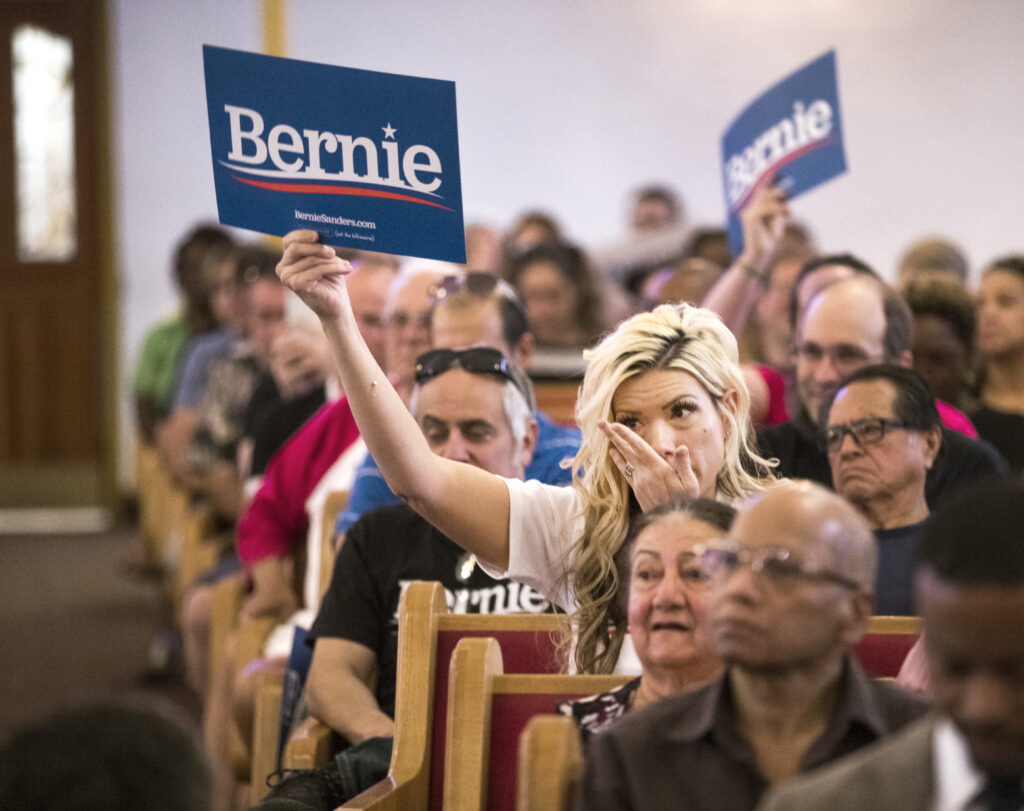
Caucus to convention
Nevada’s early nominating caucuses are fairly young, all things considered. It was only in 2008 that Nevada was granted its first-in-the-West status — meaning that its caucuses would be held only behind the early nominating contests in Iowa and New Hampshire — after Reid, then the Senate majority leader, advocated for it on the grounds that the state’s diversity makes it a good proving ground for how candidates will fare on a national level.
That means that 2020 is only the fourth time the party will put on a caucus with the eyes of the nation closely upon it.
The benefit of the caucus process, those who support it say, is that it’s good for the party. It’s an opportunity to register voters — Democrats in Nevada allow same-day voter registration for their caucuses — and many people enjoy the intimate process of getting together with their neighbors at a local school to pitch why their candidate is the best one in an attempt to woo supporters over.
“I actually had a very good experience with my caucus because the kids that my children grew up with were voting for the first time, and the kids in the room were caucusing for Bernie and the adults were caucusing for Hillary,” said Sarah Mahler, one of the Nevada delegates who represented Sanders at the national convention in 2016. “We actually had a wonderful experience.”
Others didn’t have as pleasant a time. On caucus day in 2016 there were reports of long lines, computer problems, people turning up at the wrong caucus sites and complaints about the lack of organization. On top of that, the caucus-to-convention process is inherently confusing: There are arcane rules about how to do the math to determine how many delegates representing each candidate will go to the county convention, and even more arcane rules about how — and how many — delegates get sent on to the state and national conventions, the latter of which determines who the party nominates as its presidential candidate.
It was that battle over delegates that mired the state convention in controversy in 2016. Clinton had won the caucuses at the precinct level — she won 52.6 percent of delegates to Sanders’ 47.3 percent — but Sanders had turned out more delegates to the Clark County convention, giving him a shot at picking up extra delegates at the state convention level. When Clinton was declared the winner at the state convention for having turned out more delegates, Sanders supporters cried foul, argued that their delegates had been unfairly disqualified and protested when the convention was shut down.
“Our state convention, it really was a wakeup call that we really have to have our processes in order,” Mahler said. “It was a perfect storm.”
Those sentiments carried through to the national convention. Carol Cizauskas, another Sanders delegate to the national convention, remembered being drowned out by chants of “USA” when she and others attempted to start a “no more war” chant.” She said she left the convention floor sobbing, feeling that the moment encapsulated “the worst of what the United States would stand for.”
When she returned home to Reno after the convention, she registered as a member of the Green Party.
“After all that happened I was like, ‘I can’t be a Democrat anymore,’” Cizauskas said. But when she decided to vote “none of these candidates” instead of supporting Clinton “there were so many people who were so angry at me. They said, ‘Bernie said you have to vote for Hillary,’ and I said, ‘I learned from Bernie that for the first time in my life I didn’t have to settle.’”
It was so bad that she attributes her decision to leave Nevada and move to Wisconsin in 2017 in part to what happened during the last presidential nominating process.
“What put us over the top was how ugly the politics were from the Democrats, from the people who had been Bernie people who were so awful when I was clear I couldn’t support and wouldn’t support [Clinton],” she said. “It was like, we have to get out of here, we have to go somewhere where we can try again.”
The state party, realizing how divisive the election had been, started taking steps to salve old wounds: The party launched a statewide listening tour; had then-Minnesota Rep. Keith Ellison, a 2016 Sanders supporter, out to moderate a discussion; met with Sanders and his team; and began looking at changes to the process through its caucus-to-convention committee.
Before releasing its delegate selection plan for 2020, the party hosted 10 conference calls in five weeks and even individually called state central committee members to get their feedback.
Adam Littman, a Sanders delegate to the national convention, acknowledged that the party has made “a huge effort to appear transparent” and “appear responsive.” But he still remains unsure whether that's a genuine effort. He said he never received a satisfactory answer, for instance, about why the party is continuing to offer at-large precincts on the Strip on the day of the caucus — meant to allow hotel workers to caucus while at work — when it is also offering early voting and tele-caucusing.
(Littman’s concern is that those caucus sites are primarily intended for members of the Culinary Union, which plays an outsize role in Nevada elections when it endorses a candidate by getting its members out to the polls and was credited with giving a last minute boost to Clinton in 2016.)
“There is not a whole lot of confidence that the party itself is operating in good faith — not to say that they aren’t,” Littman said. “I can’t speak for anybody’s intention.”
This is the primary obstacle for the Democratic Party this cycle: Even if the caucus process is above board and by the books, how does the party convince its members that it is? Unlike a state-run primary, the caucus is run by the party and for purposes of choosing who it wants to put up for the presidential nomination, meaning that it sets the rules and polices itself within its own internal structure.
“There are no consequences to being a bad actor in the caucus process,” said Christine Kramar, another Sanders delegate in 2016. “If you’re an elections official in this process, and you committed election fraud, you’d be risking a charge, a criminal charge. In the caucus process, there’s nothing holding you to be neutral.”
Beyond that, there are concerns about how the results of early voting and the tele-caucus will be able to be verified, particularly because the results of those two voting methods will flow directly into the totals at each person’s home precinct. For instance, if Candidate A has more supporters turn out to the in-person caucus but Candidate B has more support in early voting and the tele-caucus, Candidate A’s supporters might ask for some sort of additional verification that the other two vote totals are correct.
“A lot of the questions don’t come from a philosophical viewpoint of thinking it’s a bad idea of having more people participate,” Littman said. “I don’t know any progressives that are still part of the Democratic Party who don’t want more people to participate ... but we actually want those numbers to be accurate. We want oversight. We want the ability to audit those results.”
Alana Mounce, the state party’s executive director, said that the party has committed to releasing the raw vote totals for each candidate, but has not yet decided whether it will release the breakdown between the three voting methods.
“We’re still finalizing exactly what it will look like,” she said.
For Littman, it comes down to trust.
“The answer is, ‘Trust us, trust the system,’” Littman said. “But that’s not a trust that was earned with the last go around or has been cultivated since.”
The Sanders campaign is telegraphing its confidence in the process, though Shakir, Sanders’ campaign manager, said he doesn’t fault people for being suspicious.
“Last time around’s experience caused people to feel upset about the finger being put on the scale, and I understand some of that makes people worry this time,” Shakir said. “But what I can assure is that the campaign leadership will do everything it can to push for fairness from the party and, right now, we feel good that we are being treated fairly.”
Shakir talks daily to the Democratic National Committee and Sarah Michelsen, Sanders’ state director, is in regular contact with Mounce and party Caucus Director Shelby Wiltz. The Sanders campaign even recently sent out a joint fundraising email with the state party, the first in a series that the party is planning to do with the various presidential campaigns.
For now, the Sanders campaign and the state party are doing what they can to ensure the integrity of that process. Even Mahler, one of the 2016 Sanders delegates, said that the rockiness of the last election inspired her to get more involved: She is now chair of the Washoe County Democratic Party.
“I’m the 2016 Bernie delegate that stepped up to leadership, and I’ve been welcomed — maybe not every single step of the way but certainly right now,” Mahler said. “We all are on the same team.”
The state party is taking the lessons learned from 2016 and building out its caucus team earlier than ever before. It brought on Wiltz as caucus director in March and is already reaching out to labor organizations and other partner groups to focus on training and education. It is also stressing its commitment to neutrality through its new chair, Assemblyman Will McCurdy.
“I’m making sure folks know where I stand,” he said. “Chairman McCurdy will not be endorsing anyone.”
Nationally, the party has eliminated the ability of superdelegates to vote on the first round of ballots, which leaves selecting the party’s nominee up to the delegates selected through the caucus and primary process. Superdelegates will only be allowed to participate in the nominating process if the party reaches a gridlock on the first ballot and has to take a second or subsequent vote. Sanders acknowledged the progress on this front.
“Last time around, we started off the campaign process 500 votes behind Hillary Clinton before the first vote was cast in Iowa,” Sanders said. “We did not go as far as I wanted to, but we have eliminated superdelegates voting on the first ballot. That means that all candidates start off at an even level, not 500 votes behind as was the case last time. So I think that is a step forward.”
There is widespread agreement that there should be participation in the process. For Team Sanders, non-participation means the Vermont senator won’t be the party’s nominee. For progressives broadly, non-participation in the process means the Democratic Party will likely select a moderate candidate, such as former Vice President Joe Biden, they may never be able to support. For the party, non-participation means a high likelihood that President Donald Trump will be re-elected to a second four-year term.
“I was phone banking last week with our team and talked to someone who said ... ‘I caucused in 2016 and then Bernie lost and I don’t want to participate again.’ I talked to him and told him about how Medicare-for-all would affect me and my family,” Michelsen, Sanders’ state director, said. “You have to reiterate the importance that, even if you felt shut out last time, the only way to not be shut out is to participate.”
Sanders said that he will support whoever the eventual 2020 Democratic presidential nominee is. But he still balks at the suggestion that he didn’t do enough to get Clinton elected in 2016.
“I resent very much anyone suggesting otherwise,” Sanders said. “I went to 13 states in this country, including Nevada. I knocked my brains out to do everything that I could.”
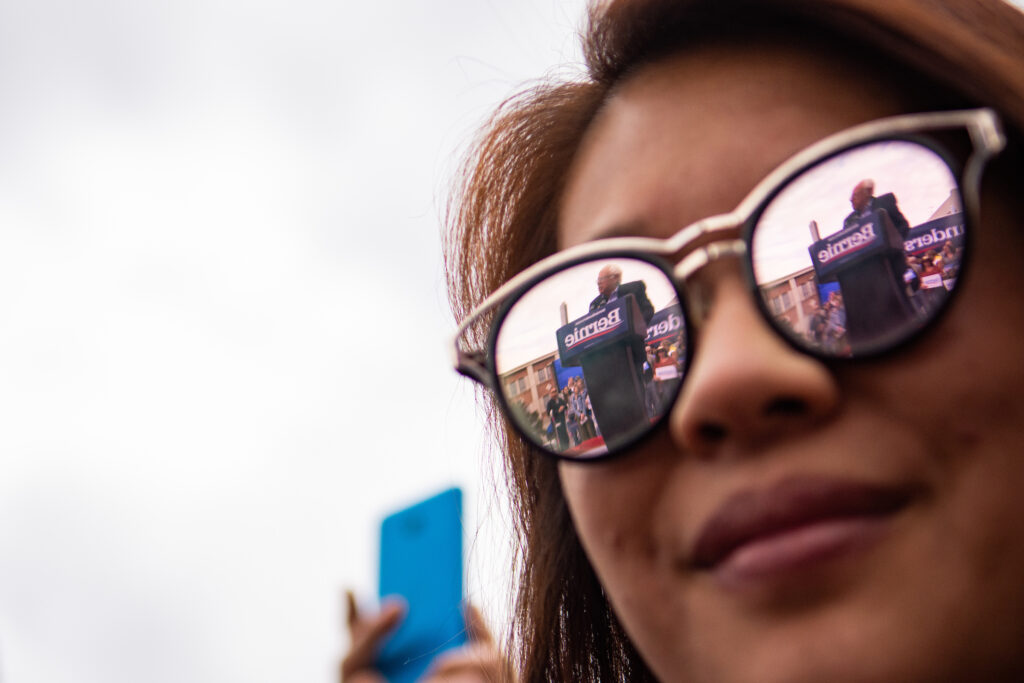
Bernie 2016 vs. Bernie 2020
It’s not just the party that’s taking a different tack this time around: Sanders’ team is too.
“Last time around it was certainly, I think, a movement of ideas that happened to take off and had a chance to win that became realized over time,” Shakir said. “This time around we are benefited by the fact that there is this movement for all of these ideas that exists and we need to shape that into a strategy to win the nomination, win the presidency, and put Bernie Sanders in the White House.”
This time, Sanders announced his 2020 presidential campaign on Feb. 19, a little more than two months earlier than his April 30 announcement four years ago. It wasn’t just the early announcement either: Sanders’ team also immediately started building out its operation in the early nominating states, including announcing three early hires in Nevada in March. Now, Sanders has 40 staffers on the ground here in Nevada and is continuing to grow, according to his campaign.
“If you take Nevada, we’re already light-years ahead in our organization and our operation in that state and therefore I would argue in a better position to win the caucus,” Shakir said.
Now, the Sanders campaign is focused on building enthusiasm, including through its barnstorm program. Part of the plan, Shakir said, is to have the campaign “crest at the right time.”
“In my view, it’s early. A lot of people haven’t checked into this race yet. I can totally appreciate and understand from this campaign’s perspective toward working class America that people are busy,” Shakir said. “Now is not the time I would expect or want this massive high-enthusiasm, high-burn campaign.”
Clark County Commissioner Tick Segerblom, who chaired Sanders' Nevada campaign in 2016, noted the differences between the 2016 and 2020 operations.
“He has the resources and the time and using them to build a grassroots network, but Nevada is the real beneficiary of that,” Segerblom said.
But not all Sanders supporters from 2016 feel the same way. Kramar, for instance, said that she and other grassroots volunteers have been passed over for paid positions on Sanders 2020 campaign. She said that volunteers were willing to devote their time to Sanders before because his campaign was scrappy and didn’t have the money; now that it’s flush with cash, she can’t understand why she and others haven’t been brought into the fold.
“We feel pretty flipping betrayed by Bernie Sanders,” Kramar said.
Some of that ire is directed specifically at Reid and his former staffers on the Sanders campaign, which, at the national level, includes Shakir and Sanders chief of staff Ari Rabin-Havt.
“Faiz and Ari, they want to run it Harry Reid’s way, and in Nevada we know how Harry Reid’s way and how Searchlight’s way, and all of that, runs,” Kramar said. “There isn’t going to be a place at the table for activists.”
The counter from Shakir is that it is Reid’s leadership that has led Democrats to victory in the Silver State.
“You can have whatever criticisms you want of the Reid machine, but the Reid machine wins,” Shakir said. “I also think that Bernie Sanders, while he shares a lot of the same convictions of Harry Reid, he is a different person in his own right ... I think what he can do is take a successful and existing machine in Nevada and add more gasoline to that fire by bringing people into that process.”
Shakir added that the campaign is continuing to ramp up and that people who applied to work on the campaign and felt slighted will hear from the campaign soon.
“You’re in a moment right now where you’re at the cusp of what will be and what always was our plan to have a late summer, early fall growth of an army of paid staff not only in Nevada, but in Iowa, New Hampshire and South Carolina,” Shakir said. “People who feel like they weren’t hearing anything in April or May, I promise you that you will hear something in July or August.”
Sanders has voiced full confidence in his team.
“We have a great campaign leadership. We have a great staff. You saw them here in Nevada,” Sanders said. “Nevada is a very, very important state in terms of the political process, and we expect to win this state. Our campaign formula is not very complicated … You win this thing at the grassroots level. That's what you do.”
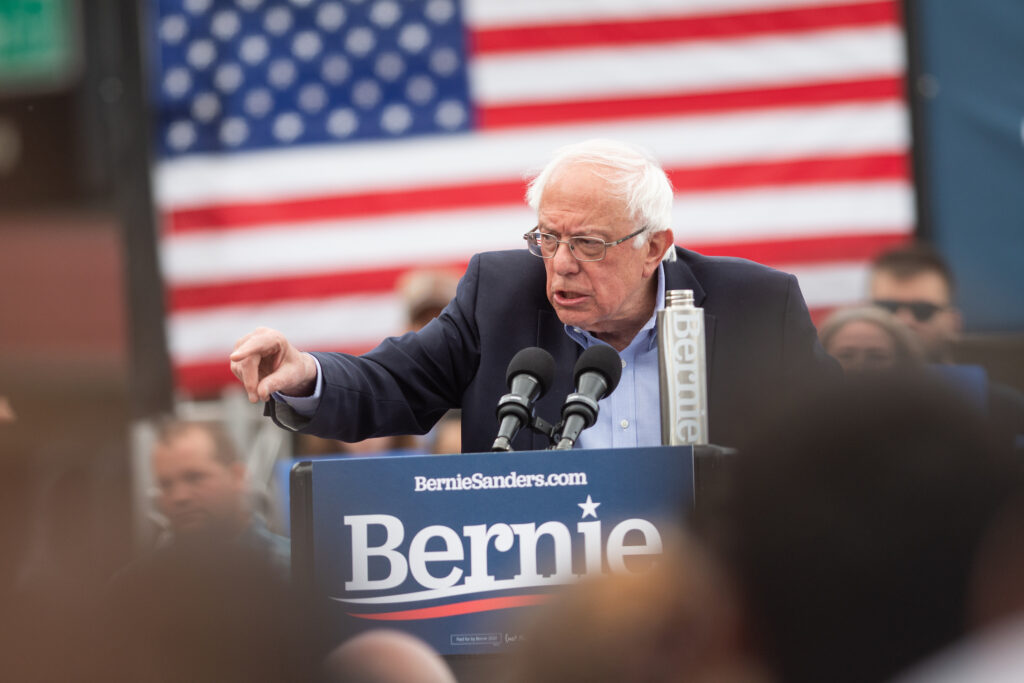
Shifting tides
Those changes in the campaign — coupled with a significantly wider Democratic field with candidates who have been open to embracing portions of Sanders’ progressive agenda — mean that not all Sanders supporters from 2016 are on board this time around.
“I still believe in Bernie Sanders as a good man,” Kramar said. “But you cannot take the loyalty of people for granted. What’s happening right now is they have taken the loyalty of Bernie Sanders supporters for granted.”
Kramar said that she’s seen some disenchanted Sanders supporters eyeing self-help author Marianne Williamson. She noted, for instance, Williamson’s plan to pay the descendants of African-American slaves $500 billion in reparations, where Sanders has only said he supports a study on the issue. Plus, she likes Williamson’s approach.
“What Marianne has that Bernie Sanders doesn’t have is interpersonal feeling of warmth,” Kramar said. “I’ve met the man several times. He reminds me of my grandfather. But he’s not a warm and fuzzy. Marianne Williamson is warm and fuzzy as the day is long.”
Cizauskas, who now lives in Wisconsin, is still considering Sanders, but Williamson is her first choice. (Her third choice is Gabbard, and she’s mulling over New Jersey Sen. Cory Booker.)
Williamson “stands for the same things Bernie does but she comes at it from an even purer standpoint,” Cizauskas said. “I’m all in for Marianne.”
Littman, however, believes that most Sanders supporters are sticking with him, though he has heard of a few joining the “Yang train.”
“If Bernie is running, and you truly support the policies that Bernie puts forward why would you go for Bernie light?” Littman said. “The Bernie support I’ve seen isn’t flagging here. It’s increasing, because we don’t want to see what happened in 2016 happen again.”
Amy Vilela, a former Democratic congressional candidate and Sanders surrogate, echoed those sentiments.
“I can tell you I’m down here on the ground when I’m able to be involved, and I’m seeing faces I know have been supporters since 2016,” Vilela said. “Of course there’s a lot of new faces, because it means there were new people who weren’t particularly involved before.”
Yvette Williams, chair of the Clark County Black Caucus, said that her organization endorsed Sanders in 2016 but hasn’t decided who it will support in the upcoming election. The caucus sat down with Sanders and Booker and is hoping to interview Warren and California Sen. Kamala Harris.
“I think Elizabeth Warren has been able to cut into some of Bernie’s supporters from last time,” Williams said. “Many of us wanted Elizabeth Warren to run last time. I was one of them.”
Segerblom said that his “heart is with Bernie” and that “to abandon him at this point would be really difficult for me,” but he hasn’t officially endorsed anyone yet. He has, however, hosted Warren, Booker and Gabbard at his house.
And then there are the first-time voters, such as 20-year-old Patricia De La Hoya. At a rally last month, the University of Nevada, Reno student said Sanders’ consistency appeals to her. The other candidates, she said, are talking about progressive policies, including Medicare-for-all and a $15 an hour minimum wage, but she credits him with creating the conversation.
“Now all the other candidates are adopting it,” she said. “But Bernie definitely sparked that, I think, for this community and pushing more to a leftist agenda.”
